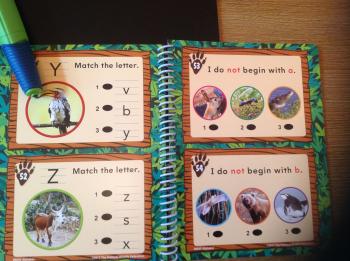
PROJECT TITLE: STEAM to Reach All Learners, with a Little Help from Ranger Rick

- School:
- Sea Gate Elementary
- Subject:
- Stem
- Teacher:
- Lorrie Dixon
- Students Impacted:
- 18
- Grade:
- K
- Date:
- September 11, 2018
Investor
Thank you to the following investor for funding this grant.
Suncoast Credit Union - $684.00
Original Grant Overview
Goal
Throughout the Kindergarten Cambridge training that I attended in January 2018, and throughout the summer Collier County Public Schools Cambridge training, the key words were: student-driven, hands-on, curiosity, and engagement. In Science class, students need to be given the opportunity to explore and to ask questions. If they cannot visit every country in the world to observe plants and animals, then, let us give them the chance to see these things in vivid photographs and to touch realistic replicas. My objective is to help children feel like real scientists through making incredible discoveries! They will do this with the Science specimen centers that include objects such as: a turtle shell, an iguana skull, a starfish, a shark tooth, and a peacock feather. The specific learning goals of this activity include: "Students will be able to make and learn from careful observations using their senses" (SC.K.N.1.5) and "students will be able to understand plants and animals are alike and different in the way they look and in the things they do" (SC.K.L.14.3).
Student learning will be enhanced with Ranger Rick Jr. Magazines and with the Science nonfiction books. I will be reading the magazine articles and the books to the children. Some of the nonfiction book titles in the set are: Run, Swim, Fly and Who Do I Look Like? A Book about Animal Babies. With the reading activities, the goal is for students to be accomplished at "asking and answering questions about key details," "identifying the main topic and key details," and "asking and answering questions about unknown words" in nonfiction texts (LAFS.K.RI.1.1, LAFS.K.RI.1.2, LAFS.K.RI.2.4).
While keeping with the natural world theme, which I have also incorporated in my classroom with a reading tent and woodland animal décor, I am requesting Ranger Rick Alphabet books, Sight Words books, Number books, and Addition and Subtraction books. These self-correcting books will be used with Ranger Rick pens that light up and provide encouragement for students to learn alphabet letters and beginning letter sounds in words, read sight words, and sort words into rhyming word families. Kindergarten students need these foundational reading skills, obviously, but these materials will help to make the connection between Smithsonian Institute photographs of real animals and alphabet letters and words. The reading learning goals for students include: "demonstrating an understanding of spoken words, syllables and sounds" and "applies grade level phonics and word analysis skills in decoding words" (LAFS.K.RF.2.2, LAFS.K.RF.3.3). The mathematics learning goals for students include: "reading and writing numerals from 0 to 20," "count to answer 'how many' questions about as many as 20 things," and "add and subtract within 10" (MAFS.K.CC1.3, MAFS.K.CC.2.5, MAFS.K.OA.1.2).
What will be done with my students
The activities that are planned with these materials include:
1. Ranger Rick Jr. Magazine- The stories and articles will be read aloud to children and the magazines will be perused by the children as they become readers in Kindergarten.
2. Ranger Rick Alphabet Books, Sight Words/Word Family Books, Number Books, Addition and Subtraction Books and the Ranger Rick Power Pens- The way that I plan to use these materials is during small group instruction at first, to teach the children how to use the books. Then, the books and pens will become part of our Literacy Centers, which will be great because the books are self-correcting! I would also like to use the books and Power Pens as an activity to differentiate instruction, allowing students who are early finishers to practice or to stretch their learning while I help other learners grasp foundational Reading, Writing or Math skills. On a side note, I am working on my Gifted Endorsement and I feel that these materials are quite appropriate for extending the standards, as well.
3. My Science Library Set K-1- The nonfiction books will be read aloud to students by myself or by parent volunteers. Student gravitate towards the nonfiction titles during independent reading because they can “read” the pictures. They can also learn from nonfiction text features, such as captions, size comparisons, and close-ups.
4. Lakeshore Fairy Tales Problem-solving STEM Kits- Children need to plan, create, and test solutions to… help a prince scale a tower to rescue Rapunzel, to get the Gingerbread man across a river, and to build a basket for Little Red Riding Hood. Storytelling has been around for ages and all children love the imaginary play surrounding these characters. Now, they will be asked to solve a dilemma faced by a story character.
5. Hands-on Science Specimen Centers- Children will hold and explore realistic specimens from each of the animal classes: insects, birds, reptiles, mammals, and sea life. They will learn to identify characteristics of each class by studying the full-color photographs and the specimens. I plan to introduce the specimen sets during Science class and guide students in their use. Inquiry will come naturally. Materials will be rotated in and out of the Science center for exploration.
Benefits to my students
I am a lifelong learner. I become motivated when I learn new things, when I am given the support and encouragement through trainings and from community members who believe in children. When I am excited about students’ learning, I believe the students get excited about learning. Kindergarten needs to be an active place! STEAM is a relatively new term in education, but the ideas have been around for a long time. Now, I feel that those who sell educational materials are understanding the need to help students and teachers bridge subjects together, such as with storytelling and engineering (the Fairy Tales Problem-solving STEM kits), and with Science and technology (the Ranger Rick books and the power pens). All learners who will become engaged in the materials proposed in this grant will benefit from hands-on learning, from problem-solving and from constructing their own knowledge about the natural world. In the description for the Ranger Rick Jr. magazine, it states that “since 1967, Ranger Rick Jr. Magazine has been children’s gateway into the natural world. It is full of discoveries, fun activities, and cute animals that will draw children closer to nature and spark curiosity for the wild world around them.” That will be the ultimate long-range benefit of this grant: The nurturing of young nature lovers, engineers, and scientists who will take care of the future of our Earth. One of the short-range benefits will be student gains in English Language Arts with the broadening of vocabulary and letter sound knowledge. Another benefit of this grant will be student gains in Science as they acquire a deeper understanding of animals and their habitats.
Budget Narrative
The magazine subscription is for 10 issues, over the course of one year and will be ordered through Discount Mags. The Ranger Rick books, pens, and Science nonfiction book set are from Teacher Created Materials. The Science specimens and the Fairy Tales Problem-solving STEM kits are from Lakeshore Learning.
Items
| # | Item | Cost |
|---|---|---|
| 1 | Ranger Rick Jr. Magazine-one year’s subscription | $24.00 |
| 2 | Ranger Rick Power Pen Learning Book: Sight Words/ Word Families (5) | $49.95 |
| 3 | Ranger Rick Power Pen Learning Book: Alphabet Books (5) | $49.95 |
| 4 | Ranger Rick Power Pen Learning Books: Number Books (5) | $49.95 |
| 5 | Ranger Rick Power Pen Learning Book: Addition and Subtraction Books | $49.95 |
| 6 | Ranger Rick Power Pens (set of 3) | $44.97 |
| 7 | My Science Library Set K-1 (set of 12 books) | $83.88 |
| 8 | Lakeshore Fairy Tales Problem-solving STEM Kits (Little Red Riding Hood, Rapunzel, Gingerbread Man) | $149.00 |
| 9 | Hands-on Science Specimen Centers (Insects, Birds, Reptiles, Mammals, Sea Life) | $145.00 |
| 10 | Estimated Taxes | $37.35 |
| Total: | $684.00 |



Share
Please share this page to help in fulfilling this grant.
Email to a Friend